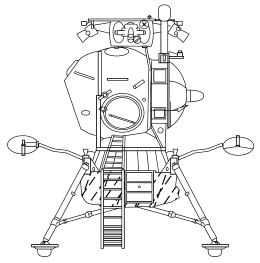Kosmos 434
Kosmos 434 (Russian: Космос 434; meaning Cosmos 434) was the final unmanned test flight of the Soviet LK Lander. It performed the longest burn of the four unmanned LK Lander tests. It finished in a 186 km by 11,804 km orbit. This test qualified the lander as flightworthy.
The LK was the only element of the Soviet manned lunar programs that reached this status. In 1980-81 there were fears that it might carry nuclear fuel. When in reentered over Australia on August 22, 1981 the Soviet Foreign Ministry in Australia admitted that Kosmos 434 was an “experiment unit of a lunar cabin,” or lunar lander.
See also
References
- ↑ "Cosmos 434". National Space Science Data Center. Retrieved 15 December 2013.
- ↑ McDowell, Jonathan. "Launch Log". Jonathan's Space Page. Retrieved 15 December 2013.
- ↑ McDowell, Jonathan. "Satellite Catalog". Jonathan's Space Page. Retrieved 15 December 2013.
External links
|
|---|
| Kosmos 390 | Kosmos 391 | Meteor 1-07 | Kosmos 392 | OPS 7776 | Intelsat IV F-2 | Kosmos 393 | Apollo 14 | NATO-2B | Kosmos 394 | Tansei 1 | OPS 5268 · Calsphere 3 · Calsphere 4 · Calsphere 5 | KH-4B No.1113 | Kosmos 395 | Kosmos 396 | Kosmos 397 | Kosmos 398 | Kosmos 399 | Shijian I | DS-P1-Yu No.39 | Zenit-2M · Nauka 2KS No.3 | Explorer 43 | Kosmos 400 | OPS 4788 | OPS 5300 | Kosmos 401 | ISIS 2 | Kosmos 402 | Kosmos 403 | Kosmos 404 | Kosmos 405 | Kosmos 406 | Tournesol | Meteor 1-08 | Salyut 1 | OPS 7899 | Soyuz 10 | Kosmos 407 | San Marco 3 | Kosmos 408 | Kosmos 409 | OPS 3811 | Kosmos 410 | Kosmos 411 · Kosmos 412 · Kosmos 413 · Kosmos 414 · Kosmos 415 · Kosmos 416 · Kosmos 417 · Kosmos 418 | Mariner 8 | Kosmos 419 | Kosmos 420 | Kosmos 421 | Mars 2 | Kosmos 422 | Kosmos 423 | Kosmos 424 | Mars 3 | Kosmos 424 | Mariner 9 | Kosmos 426 | Soyuz 11 | SESP-1 | Kosmos 427 | OPS 8709 | Kosmos 428 | Zenit-2M | Soyuz 7K-LOK mockup | Explorer 44 | Meteor 1-09 | OPS 8373 | Kosmos 429 | Tselina-OM | Kosmos 430 | Apollo 15 (PFS-1) | Molniya 1-18 | Kosmos 431 | DS-P1-Yu No.33 | Kosmos 432 | OV1-20 (LOADS-2) · OV1-21 (RTDS · LCS-4 · Gridsphere 1 · Gridsphere 2 · Gridsphere B · Rigidsphere) | Kosmos 433 | Kosmos 434 | OPS 8607 | Eole | Zenit-4M | Kosmos 435 | Luna 18 | Kosmos 436 | Kosmos 437 | OPS 5454 · OPS 7681 | Kosmos 438 | Kosmos 439 | Kosmos 440 | Shinsei | Kosmos 441 | Luna 19 | OSO 7 · TETR-4 | Kosmos 442 | Kosmos 443 · Kosmos 444 · Kosmos 445 · Kosmos 446 · Kosmos 447 · Kosmos 448 · Kosmos 449 · Kosmos 450 · Kosmos 451 | OPS 4311 | Kosmos 452 | ASTEX | Kosmos 453 | ITOS-B | OPS 7616 | Prospero | Kosmos 454 | OPS 3431 · OPS 9432 | STV-4 | Explorer 45 | Kosmos 455 | Kosmos 456 | Kosmos 457 | Molniya 2-01 | Kosmos 458 | Kosmos 459 | Kosmos 460 | Interkosmos 5 | Kosmos 461 | Kosmos 462 | Zenit-2M · Nauka 5KS No.2 | Canyon | Polaire | Kosmos 463 | Kosmos 464 | Ariel 4 | OPS 7898 PL-2 · OPS 7898 PL-1 · OPS 7898 PL-3 · OPS 7898 PL-4 | Kosmos 465 | Kosmos 466 | Kosmos 467 | Kosmos 468 | Molniya 1-19 | Intelsat IV F-3 | Kosmos 469 | Kosmos 470 | Oreol 1 | Meteor 1-10 | | Payloads are separated by bullets ( · ), launches by pipes ( | ). Manned flights are indicated in bold text. Uncatalogued launch failures are listed in italics. Payloads deployed from other spacecraft are denoted in brackets. |
|

